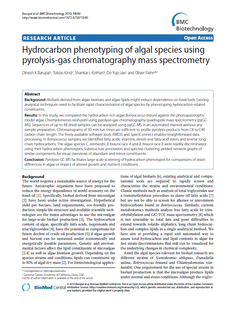
Hydrocarbon phenotyping of algal species using pyrolysis-gas chromatography mass spectrometry came out in May of this year in BMC Biotechnology. What I liked about this paper was the use of free and open source software as well as the fact that this paper is available through open access for anyone to read.
Dinesh Barupal (first author of the paper) was kind enough to take me through the process used in the paper in the paper when I visited Dr. Feihn’s lab. From what I saw, it is as easy as the papers outlines it to be!
Advantages
Hydrocarbon profiles have a tremendous effect on the biofuel properties. Hydrocarbon profiles seem to be a secondary focus to oils, with most people focusing only on the final percentage of algae oils or lipids. Knowing which algae have hydrocarbon profiles best suited for biofuels, or which factors (temperature, lighting, nutrients etc) effect hydrocarbon profiles is important in producing consistent high grade biofuels.
You can find the paper’s abstract below:
Background
Biofuels derived from algae biomass and algae lipids might reduce dependence on fossil fuels. Existing analytical techniques need to facilitate rapid characterization of algal species by phenotyping hydrocarbon-related constituents.
Results
In this study, we compared the hydrocarbon rich algae Botryococcus braunii against the photoautotrophic model algae Chlamydomonas reinhardtii using pyrolysis-gas chromatography quadrupole mass spectrometry (pyGC-MS). Sequences of up to 48 dried samples can be analyzed using pyGC-MS in an automated manner without any sample preparation. Chromatograms of 30-min run times are sufficient to profile pyrolysis products from C8 to C40 carbon chain length. The freely available software tools AMDIS and SpectConnect enables straightforward data processing. In Botryococcus samples, we identified fatty acids, vitamins, sterols and fatty acid esters and several long chain hydrocarbons. The algae species C. reinhardtii, B. braunii race A and B. braunii race B were readily discriminated using their hydrocarbon phenotypes. Substructure annotation and spectral clustering yielded network graphs of similar components for visual overviews of abundant and minor constituents.
Conclusion
Pyrolysis-GC-MS facilitates large scale screening of hydrocarbon phenotypes for comparisons of strain differences in algae or impact of altered growth and nutrient conditions.
Dinesh Barupal (first author of the paper) was kind enough to take me through the process used in the paper in the paper when I visited Dr. Feihn’s lab. From what I saw, it is as easy as the papers outlines it to be!
Advantages
- Minimal sample required: the method requires very little (1 mg dry weight) sample of biomass to do the analysis. This allows for more analysis to be done with biomass.
- No oil extraction: there is no oil extraction analysis requirement. This translates into time savings in the lab, and has the added benefit of eliminating differences in methodologies and technicians when doing extractions.
- Fast: the pyrolysis-GCMS method has the potential to process 36 samples per day.
- Accelerated data analysis: using a batch based data processing approach allows a number samples can be analyzed and compared between one another to identify differences.
- Lots of data: An added benefit to using the GCMS method is there is lots of data about other compounds (ie: higher value products) that can be looked at more closely.
- AMDIS - AMDIS is an acronym for Automated Mass Spectral Deconvolution and Identification System. This software was used to analyze the files that were batch processed by SpectConnect.
- SpectConnect - their tagline is “Analyze your GC/MS data in three steps...” This service is hosted by MIT, but can be downloaded and run on a separate computer or server.
- Cytoscape - is an open source way to visualize complex networks or data sets.
Hydrocarbon profiles have a tremendous effect on the biofuel properties. Hydrocarbon profiles seem to be a secondary focus to oils, with most people focusing only on the final percentage of algae oils or lipids. Knowing which algae have hydrocarbon profiles best suited for biofuels, or which factors (temperature, lighting, nutrients etc) effect hydrocarbon profiles is important in producing consistent high grade biofuels.
You can find the paper’s abstract below:
Background
Biofuels derived from algae biomass and algae lipids might reduce dependence on fossil fuels. Existing analytical techniques need to facilitate rapid characterization of algal species by phenotyping hydrocarbon-related constituents.
Results
In this study, we compared the hydrocarbon rich algae Botryococcus braunii against the photoautotrophic model algae Chlamydomonas reinhardtii using pyrolysis-gas chromatography quadrupole mass spectrometry (pyGC-MS). Sequences of up to 48 dried samples can be analyzed using pyGC-MS in an automated manner without any sample preparation. Chromatograms of 30-min run times are sufficient to profile pyrolysis products from C8 to C40 carbon chain length. The freely available software tools AMDIS and SpectConnect enables straightforward data processing. In Botryococcus samples, we identified fatty acids, vitamins, sterols and fatty acid esters and several long chain hydrocarbons. The algae species C. reinhardtii, B. braunii race A and B. braunii race B were readily discriminated using their hydrocarbon phenotypes. Substructure annotation and spectral clustering yielded network graphs of similar components for visual overviews of abundant and minor constituents.
Conclusion
Pyrolysis-GC-MS facilitates large scale screening of hydrocarbon phenotypes for comparisons of strain differences in algae or impact of altered growth and nutrient conditions.
 RSS Feed
RSS Feed
